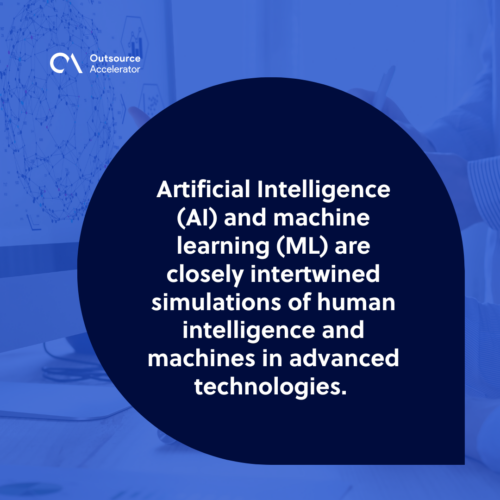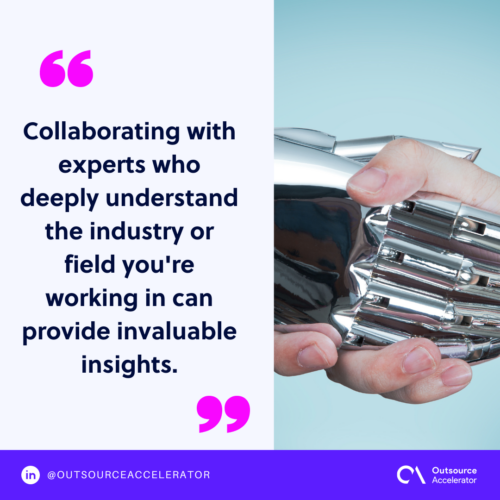AI and ML solutions: Benefits and how to build them

The convergence of artificial intelligence (AI) and machine learning (ML) has catalyzed a monumental shift in how every businesses approach problem-solving and innovation.
These two groundbreaking technologies have ceased to be mere buzzwords, instead solidifying their status as indispensable tools driving the progress of industries worldwide.
But despite newer generations finding the power of AI and ML solutions remarkable, others still find that these advanced technologies are old news.
“AI is really kind of not a new type of technology [and] the machine learning also is not new,” Vadim Peskov mentioned, CEO and co-founder of Diffco, at the 452nd episode of the Outsource Accelerator podcast.
Diffco does outsourcing services but mainly focuses on providing SaaS, software, and artificial intelligence solutions, among others. The firm also has a comprehensive grasp of international markets and has received several awards for its mobile and app development work.
Moreover, although it’s true that the transformative capabilities of AI and ML in reshaping organizational processes are not entirely ‘brand new,’ these solutions are continuously evolving and revolutionizing industries.
But the question is, how can you build efficient AI and ML solutions for your client’s needs?
Understanding AI and ML solutions
Artificial Intelligence (AI) and machine learning (ML) are closely intertwined simulations of human intelligence and machines in advanced technologies.
Understanding the core concepts of AI and ML solutions is crucial to grasp their potential and how they work together to drive innovation across various industries.

Explaining AI and machine learning’s differences
Artificial intelligence encompasses a broader spectrum of technologies, while machine learning is a specific technique.
AI involves creating machines capable of intelligent behavior, and ML provides the means for machines to learn and improve their performance through data-driven experiences.
In other words, AI sets the stage, and ML takes the spotlight by making AI systems smarter over time.
Role of data in training AI and ML models
Data serves as the lifeblood of AI and ML solutions. These technologies thrive on vast data to train models and improve their accuracy.
The quality and quantity of data play critical roles in the success of AI projects.
Raw data is fed into algorithms, learning patterns, correlations, and dependencies. The AI and machine learning models‘ ability to generalize from this data enables businesses to perform tasks, make predictions, and assist in decision-making.
How to build effective AI and ML solutions
While the concept of AI has been around for decades, recent advancements in computing power and data availability have propelled its development to new heights.
Businesses can create different automation models and can explore “building some internal tools” with the help of “different AI [and] ML processes.”
Building effective AI and ML solutions requires a strategic approach encompassing various key factors.
Define clear objectives
Setting clear and well-defined objectives is the foundation for your clients’ successful AI and ML solutions.
It’s essential to outline what you aim to achieve with your solution, whether improving efficiency, making accurate predictions, or enhancing user experiences.
Additionally, integrating specific budget considerations into your objectives to create AI and ML projects ensures that your goals remain financially feasible.
It can also guarantee that the development aligns with your organization’s resources.
“Sometimes you [can spend] millions of dollars [or] you can do this with like [ten] times smaller budget. It’s wonderful. But again, in some cases, it will be like, hey, why did you made this decision half a year ago?” Vadim says.
Apply iterative development
“Different things will work better for different clients,” says Vadim. This understanding aligns seamlessly with the iterative development approach in building AI and ML solutions.
Instead of striving to achieve a flawless model in a single attempt, the iterative process entails progressively developing, evaluating, and honing your AI and ML solutions.
By adopting this method, you can promptly pinpoint potential challenges and implement essential modifications. This iterative strategy facilitates the creation of a more resilient and impactful end product tailored to the specific needs of individual clients.
Preprocess and clean data
Data quality is paramount in AI and ML solutions. Preprocessing and cleaning data involve transforming raw data into a usable format.
It also involves eliminating inconsistencies, errors, or outliers that could negatively impact your models’ performance.
This step ensures that your AI and ML models learn from accurate and reliable information, leading to more accurate predictions and insights.
Regularly update models
The field of AI and ML is dynamic and constantly evolving. To maintain your solutions’ effectiveness, updating your models regularly is essential.
New data, changing trends, and technological advancements can influence model performance. Note that “every day [is] something new. If you forget to check the news, [you] typically will miss [the trend].”
Further, you can adapt to evolving circumstances by fine-tuning your models and ensuring your solutions remain relevant and accurate.
Collaborate with domain experts
Effective AI and ML solutions are deeply rooted in domain-specific knowledge. Collaborating with experts who deeply understand the industry or field you’re working in can provide invaluable insights.
“You can put maybe some folks that, for example, people who do different data cleaning, data, labeling, all this kind of stuff,” the Diffco CEO and co-founder suggested.
Domain experts can help you refine your objectives, validate your models, and ensure that your solutions are technically sound and aligned with real-world needs.

Benefits of AI and ML solutions to certain industry processes
As the integration of AI and ML solutions becomes increasingly prevalent, their transformative impact on various industry processes cannot be overstated.
Sentiment analysis for market research
AI-driven sentiment analysis enables businesses to gauge public opinion by analyzing social media posts, reviews, and customer feedback.
This invaluable data helps companies understand consumer sentiments, preferences, and pain points.
Quality control through computer vision
“Computer vision,” a branch of AI, transforms quality control processes across industries.
By analyzing images and videos, ML models can enable “object recognition, different character recognition, and document recognition.”
This technology ensures that only products meeting stringent quality standards reach the market, reducing recalls and enhancing customer satisfaction.
Drug discovery using AI simulations
The drug discovery process in the healthcare sector is time-consuming and expensive. AI and ML solutions are expediting this process by simulating molecular interactions and predicting the effectiveness of potential drugs.
These simulations enable medical researchers to narrow the pool of candidates, increasing the likelihood of identifying viable drugs for various diseases.
AI and ML solutions: Delivers AI products based on client needs
The realm of AI and ML solutions is not confined to pre-packaged applications.
Many companies like Diffco offer bespoke AI solutions tailored to their client’s specific requirements. This approach involves understanding each client’s unique challenges and goals.
Vadim and his team will “be happy to talk with anyone [who is] interested to learn more about how to build AI teams and really pull the development for actual development teams using the AI.” You can connect with him via his LinkedIn account.
Further, you may visit Diffco’s official website and listen to episode 452 of the Outsource Accelerator podcast here.







 Independent
Independent




